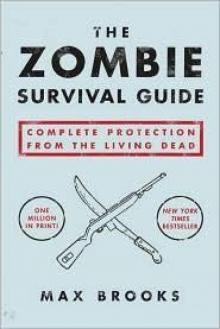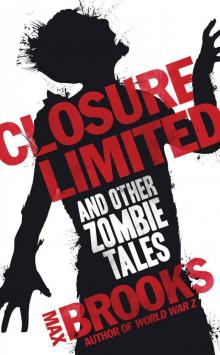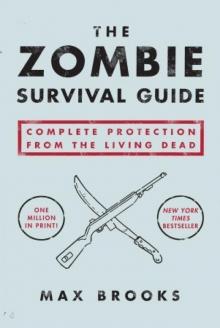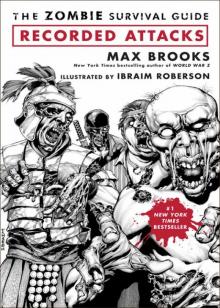- Home
- Max Brooks
The Zombie Survival Guide: Complete Protection From the Living Dead Page 11
The Zombie Survival Guide: Complete Protection From the Living Dead Read online
Page 11
B. The Bicycle
In a class by itself, this vehicle offers the best of both worlds. The common bicycle is fast, quiet, muscle-powered, and easy to maintain. Add to this the additional advantage that it is the only vehicle you can pick up and carry if the terrain gets too rough. People using bicycles to escape from infested areas have almost always fared better than those on foot. For optimum performance, use a mountain bike, as opposed to the racing or recreational model. Don’t let your speed and mobility go to your head, however. Wear standard safety gear, and choose caution over speed. The last thing you want is to end up in a ditch, legs broken, bike trashed, with the shuffling of undead feet growing louder with each step.
TERRAIN TYPES
Much of our species’ evolution has been a struggle to master our environment. Some would say we’ve gone too far. This may or may not be true. What cannot be argued, especially in the case of industrialized, First World countries, is that it is possible to assert complete control over the forces of nature. In the comforts of your own home, you control the elements. You decide when it should be hot or cold, wet or dry. You decide to erase the day by pulling the shades, or purge the night by simply turning on a lamp. Even the smells and, in some cases, the sounds of the outside world can be expunged by the walls and closed windows of the artificial bubble you call home. In that bubble, the environment takes orders from you; out in the world, on the run from a mob of ferocious zombies, the exact opposite is true. You will be at nature’s mercy, unable to change even the slightest aspect of the environment that you previously took for granted. Here, adaptation will be the key to survival, and the first step to that adaptation is to know your terrain. Every environment you encounter will have its own set of rules. These rules must be studied and respected at all times. This respect will determine whether that terrain becomes your ally or enemy.
1. FOREST (TEMPERATE/TROPICAL)
The density of many high trees enhances concealment. Animal noises, or lack thereof, can provide warning of approaching danger. Soft earth will serve to muffle your footsteps. Occasional sources of natural food (nuts, berries, fish, game, etc.) will supplement and extend your packed rations. Sleeping in the branches of a large tree may permit you a safe night’s rest. One irritating disadvantage comes from the canopy above. If you hear a helicopter overhead, you will not be able to signal it quickly. Even if the crew does spot you, they’d need a large clearing to land. This may be frustrating as you hear but are unable to see possible salvation flying right above your head.
2. PLAINS
Wide open spaces allow zombies to spot you at great distances. If possible, avoid them. If not, keep a sharp lookout for the undead. Make sure you see them before they see you. Drop to the ground immediately. Wait for them to pass. If motion is necessary, crawl. Stay down until you’ve cleared the danger zone.
3. FIELDS
For concealment, nothing works better than tall crops. The question is: Will this work to your advantage or to a lurking ghoul’s? Noise will be a critical factor. Traipsing through dry crops will create enough din to attract zombies from far and wide. Even at their wettest, travel through fields slowly, listen carefully, and be ready for close combat at any time.
4. HILLS
Traveling through rolling terrain will limit your visibility. If possible, avoid high ground. Stick to valleys. Keep an eye on the surrounding hilltops in case the unexpected zombie should spot you. High ground can be useful for getting your bearings, confirming your route, and confirming zombie locations within the area. Approach high ground with extreme caution. Travel low, on your stomach, with eyes primed for a slouching figure and ears alert for that distinctive moan.
5. SWAMP
If possible, avoid wetlands altogether. The noise of splashing through water prevents any chance of stealth. Poisonous and predatory wildlife are as much a threat as the undead. Soft mud will impede your advance, especially with a heavy pack. Always stick to firm, dry ground. If necessary, wade through only the shallowest water. Watch for ripples or any subsurface motion. A zombie might have sunk through the soft mud and be trapped just below the waterline. Look for tracks and animal carcasses. As in forests, listen to the wildlife. Their physical presence will also act as an early-warning mechanism. Hundreds of different animal and bird species live in this ecosystem. Only the threat of large predators would be enough to silence them. If you find yourself in the middle of a swamp and suddenly hear absolutely nothing, you will know the undead are close.
6. TUNDRA
This subarctic environment is the most human-friendly on earth. Long winter nights are safe for travel, as the extremely low temperatures freeze zombies in their tracks. The long summer days put sight-dependent humans on equal parity with their omnisensed, undead pursuers. This allows for more time spent on the go. Ironically, this subarctic twilight has also proven to aid in deeper, more relaxed sleep. Escapees bedding down for the “night” have consistently reported the ability to truly rest without the fear of a putrid mob rushing at them from out of the darkness.
7. DESERT
Apart from urban areas, hot, arid zones can be the most dangerous environments on earth. Even without the threat of zombies, dehydration and/or heatstroke can kill a healthy human in several hours. The best way to avoid these lethal conditions is, obviously, to travel by night. Unfortunately, this will be impossible, as night movement is highly discouraged during an outbreak. Traveling should take place for three hours after dawn and three hours before dusk. The brightest, hottest part of the day should be spent immobile and shaded. Use hours of total darkness for rest. This will slow your journey but greatly reduce the risks of attack. More than in any other terrain, make sure you either have enough water for the trek or know exactly where to obtain it. If possible, avoid deserts altogether. Never forget that this environment can kill you just as easily as any walking dead.
8. URBAN
As stated before, areas of high population density should be avoided at all costs when on the run. Within their boundaries will be a maelstrom of unspeakable chaos. Imagine a large number of people—say, half a million—left to their own devices in a city without running water, electricity, phones, food delivery, medical attention, garbage collection, fire control, or law enforcement? Now add thousands of carnivorous humanoid creatures prowling the bloodstained streets. Imagine half a million human beings—frightened, frantic, frustrated, fighting for their lives. No conventional battlefield, no riot, no “normal” breakdown in social order can possibly prepare you for the nightmare that is a city besieged by the living dead. If you must ignore all common sense and travel through an urban area, the following rules will improve (if by no means guarantee) your chances of survival:
A. Know the Area!
This rule begs repeating, because nowhere is it more vital than in urban areas. How large is the city you are entering? How wide are its roads? Where are the choke points, such as bridges or tunnels? Where are the blind alleys or dead-end streets? Are there factories, chemical plants, or other places that store hazardous materials? Where are the construction sites that might present obstacles? Are there flat, open areas such as playing fields and parks that would cut your travel time? Where are the hospitals, police stations, churches, and any other buildings where zombies might be attracted to hiding humans? One city map would be essential, an additional guidebook even better, but firsthand knowledge is the best.
B. Never Use Four-Wheeled Vehicles
The chances of finding a continuously open street from one end of a city to the other are practically nil. Unless you have a constant stream of up-to-the-second information about such a route, don’t even think of attempting to find one with your car, truck, or SUV. A motorbike will allow you to skirt blocked roads. Its noise, however, cancels this advantage. By traveling on foot or bicycle, you have the advantage of speed, stealth, and versatility in this concrete maze.
C. Use Freeways
If the outbreak has moved from active battle to fu
ll infestation, the safest route will be by freeway. Since the 1950s, freeways have been built through every large and medium-sized city in the United States. Their layouts are generally straight, decreasing travel time. Long sections are lined with tall fences or are suspended above ground, which makes it almost impossible for ghouls to reach you. If they do find an on-ramp or breach the fences, you will still have the speed to either ride away (on your bike or motorcycle) or simply run. Four-wheeled vehicles are, again, not an option, as every freeway will undoubtedly be jammed by static vehicles. Many will contain zombies—bitten humans who attempted to flee the city, succumbed to their wounds, and reanimated while still belted into their seats. Examine each vehicle before approaching, and watch for those with open or broken windows. Keep your machete handy for the sudden grasping hand. Be extremely cautious when using firearms, silenced or otherwise. Remember you are walking among a minefield of full or partially filled fuel tanks. One stray bullet or a single spark, and the living dead will be the least of your problems.
D. Remain Above Ground
Storm drains, subways, sewers, and other types of underground structures can shield you from the hordes above. However, as on freeways, you run the risk of being cornered by zombies already lurking in the area. Unlike freeways, you do not have the luxury of hopping over a wall or jumping from an overpass. If confronted, there may be no place to run. Traveling below ground also ensures permanent darkness, already one strike against you. The acoustics of most tunnels are far better than what you find above ground. While this may not allow zombies to get a fix on your position, it will set off a chain reaction throughout your subterranean passage. Unless you have expert knowledge of the system—unless you helped design, build, or maintain it—don’t go anywhere near it.
E. Watch for Friendly Fire
Even if a city or section of it has been declared “overrun” (completely taken by zombies), there may still be pockets of humanity. These survivors will undoubtedly shoot first and identify their attackers later. To avoid friendly fire, be on the lookout for gatherings of zombies. This could indicate a still-raging battle. Also, look for piles of dead bodies. They could mark the kill zone of a sniper from a nearby stronghold. Listen for gunfire, try to determine its location, and give it a wide berth. Look and listen for other signs such as smoke, lights in windows, human voices, or the sound of machinery. Again, watch for the bodies. Mounds of corpses, especially those facing one direction, denote a concerted attempt by the undead to reach an objective. The fact that they fell in the same place could mean that a well-trained sniper picked them off from a fixed range. If you feel yourself close to humans, do not attempt to contact them. Making recognizable noises or shouting, “Don’t shoot!” along the way will only attract the undead.
F. Enter by Dawn, Leave by Dusk
Unless the city is too large to traverse by daylight, never stop and rest within its limits. As has been said before, the perils suffered by rural nocturnal travel multiply a hundredfold in an urban setting. If you find yourself entering a city with only several hours of daylight remaining, retreat back into the countryside for the night. If you find yourself near a city’s limits with only minutes to sundown, keep going until you are well clear before stopping to make camp. This is the one time when traveling by night is acceptable. The countryside in darkness is always safer (relatively) than the city in broad daylight.
G. Sleep with an Escape
Some cities may be logistically impossible to cross in one day. Especially now, with urban sprawl and “in-fill” (the development of land between two urban centers), it is becoming more difficult to define a city’s limits. In these cases, it will be necessary to find a suitable place to sleep or, at least, rest for the following day. Look for buildings, preferably no more than four stories, situated close to (but not touching) each other. A building with a flat roof and only one entrance is your best temporary shelter. First, ensure that you can jump safely from one roof to another. Second, seal the door to your roof. If that proves impossible, barricade it with items that will make the greatest possible noise if broken. Third, always have a long-term escape plan as well as a short-term one. If zombies do stumble onto the roof, waking you in time to jump to the next roof, possibly the next one, and finally making it to the street, what then? Without a long-term escape plan, all you will have done is jumped into the proverbial fire.
ALTERNATE MEANS OF TRANSPORTATION
1. BY AIR
Statistics have shown that flying is the safest way to travel. When escaping an infested area, this could not be more true. Time en route compresses to minutes. Terrain and other physical barriers become insignificant. The need for food, supplies, practically every lesson of this chapter, fades as you soar well above the heads of teeming ghouls. However, traveling by air does have its disadvantages. Depending on the type of aircraft and the conditions in question, these disadvantages could cancel any perk of taking to the air.
A. Fixed-Wing Aircraft
For speed and availability, nothing beats the standard airplane, assuming at least one person in your group knows how to fly one. Fuel will literally be a matter of life and death. If your journey requires a refueling stop, make sure you know its exact location and can be assured of a safe arrival. In the first stages of outbreaks, many private citizens have taken off in their private planes with no knowledge of their destination. Many crashed, while others tried to refuel at infested areas. In one case, a former stunt pilot flew his plane out of the danger zone, ran out of fuel, and attempted to parachute to safety. By the time he touched down, every zombie within a ten-mile radius had seen his plane crash and were slowly approaching his position. (The result was reported by another pilot.) Pontoon aircraft negates this potential hazard (provided you remain over water). However, ditching in the middle of a lake or ocean may leave you safe from ghouls but not from nature. Read accounts of World War II pilots who spent weeks in life rafts after being shot down, and you may want to think twice before climbing into your amphibious bird.
B. Helicopter
The ability to land on any structure, at any time, presents a giant leap above fixed-wing aviation. Running out of fuel is not a death sentence, as you do not need an airstrip to land. But what if you come down in a hostile environment? The noise alone will announce your presence. Apply the same rules of fixed-wing aircraft concerning refueling.
C. Balloon
One of the most primitive flying machines is actually one of the most efficient. A balloon, either hot-air or helium, can remain aloft for weeks. The disadvantage, however, is a lack of propulsion. Balloons depend largely on wind and thermal currents to carry them. Unless you have extensive experience, heading off in a balloon may do little more than leave you hanging helplessly above hostile ground.
D. Airship
They may look ridiculous, they may be almost impossible to find, but if you’re looking to travel by air, nothing is better than a helium-filled dirigible. These blimps, perfected during World War I and well on their way to replacing airplanes, were almost abandoned after the Hindenburg disaster of 1937. Today they exist as little more than floating billboards or airborne cameras for sporting events. During an infestation, however, they combine the longevity of a balloon with the mobility and all-terrain landing ability of a helicopter. Airships have been used four times during zombie outbreaks—once for escape, once for study, and twice for search-and-destroy missions. All were resounding successes.
2. BY WATER
Boats, in almost any form, have been found to be the safest form of transport during an attack. As stated previously, although zombies do not use their lungs and can travel underwater, they lack the coordination to swim. For this reason, traveling by boat has many of the same advantages as flying. Many times, people escaping across some body of water have looked down to see ghouls looking up at them from the bottom. Even if the keel of their boat is less than an inch out of the zombie’s reach, the humans inside have nothing to fear. Studies have shown th
at over-water escapes have a survival ratio five times that of land. Because most of the United States is riddled with rivers and canals, transport is theoretically possible for hundreds of miles. In some cases, humans using boats as artificial islands on lakes or ponds have existed for weeks while the shores swarmed with living dead.
A. Types of Propulsion
1. Motor: Fossil fuel allows not only greater speed but unmatched control in any type of waterway. The obvious drawback, however, is its finite supply. Again, either make sure you have enough fuel for the entire voyage or know exactly where safe, plentiful stocks are kept. Another problem is, as can be expected, noise. Traveling at slower speeds will conserve fuel but also alert every zombie within earshot of the bank (a slow engine makes as much noise as a fast one). Fossil-fueled engines do have their place. In a pinch, they can provide an extra burst of power. Use them only when necessary, and always be careful.
2. Sail: Wind is a consistent source of energy. Harnessing it will allow you to travel without the worry of rationing fuel. Other than the flapping of loose sails, wind-powered craft have the noise signature of floating kelp—almost zero. Unfortunately, wind is also highly unpredictable. A calm day could leave you stranded; a strong gale could cause you to capsize. Nine times out of ten, the wind will not be blowing in the right direction. Even if it is, slowing or stopping won’t be as easy as turning off the engine. Any novice can pilot a motorboat like a Boston whaler, but sailing requires skill, patience, intelligence, and years of practice. Remember this before you run to the nearest day sailor, hoist the jib, and find the wind blowing directly toward the living dead.

 World War Z: An Oral History of the Zombie War
World War Z: An Oral History of the Zombie War Minecraft: The Island
Minecraft: The Island The Zombie Survival Guide: Complete Protection From the Living Dead
The Zombie Survival Guide: Complete Protection From the Living Dead Closure, Limited and Other Zombie Stories
Closure, Limited and Other Zombie Stories Devolution: A Firsthand Account of the Rainier Sasquatch Massacre
Devolution: A Firsthand Account of the Rainier Sasquatch Massacre The Zombie Survival Guide
The Zombie Survival Guide World War Z
World War Z Closure, Limited
Closure, Limited The Zombie Survival Guide: Recorded Attacks
The Zombie Survival Guide: Recorded Attacks World War Z_An Oral History of the Zombie War
World War Z_An Oral History of the Zombie War The Essential Max Brooks: The Zombie Survival Guide and World War Z
The Essential Max Brooks: The Zombie Survival Guide and World War Z